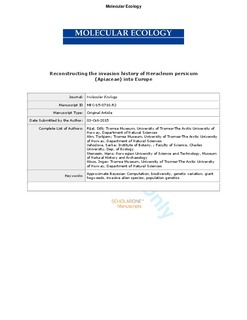| dc.description.abstract | Sparse, incomplete and inappropriate historical records of invasive species often hamper invasive species management interventions. Population genetic analyses of invaders might provide a suitable context for the identification of their source populations and possible introduction routes. Here, we describe the population genetics of Heracleum persicum Desf. ex Fisch and trace its route of introduction into Europe. Microsatellite markers revealed a significantly higher genetic diversity of H. persicum in its native range, and the loss of diversity in the introduced range may be attributed to a recent genetic bottleneck. Bayesian cluster analysis on regional levels identified three and two genetic clusters in the native and the introduced ranges, respectively. A global structure analysis revealed two worldwide distinct genetic groups: one primarily in Iran and Denmark, the other primarily in Norway. There were also varying degrees of admixture in England, Sweden, Finland and Latvia. Approximate Bayesian computation indicated two independent introductions of H. persicum from Iran to Europe: the first one in Denmark and the second one in England. Finland was subsequently colonized by English populations. In contrast to the contemporary hypothesis of English origin of Norwegian populations, we found Finland to be a more likely source for Norwegian populations, a scenario supported by higher estimated histor-ical migration from Finland to Norway. Genetic diversity per se is not a primary determinant of invasiveness in H. persicum. Our results indicate that, due to either pre-adaptations or rapid local adaptations, introduced populations may have acqu-ired invasiveness after subsequent introductions, once a suitable environment was encountered. | nb_NO |
